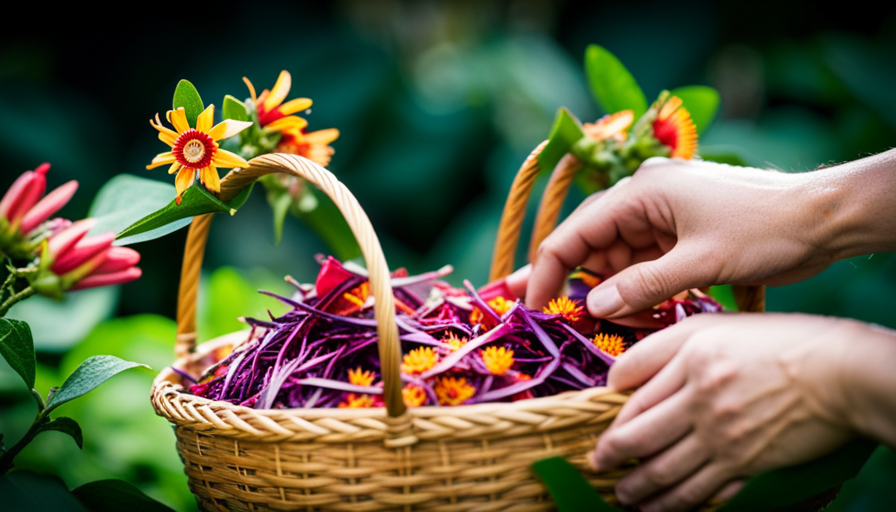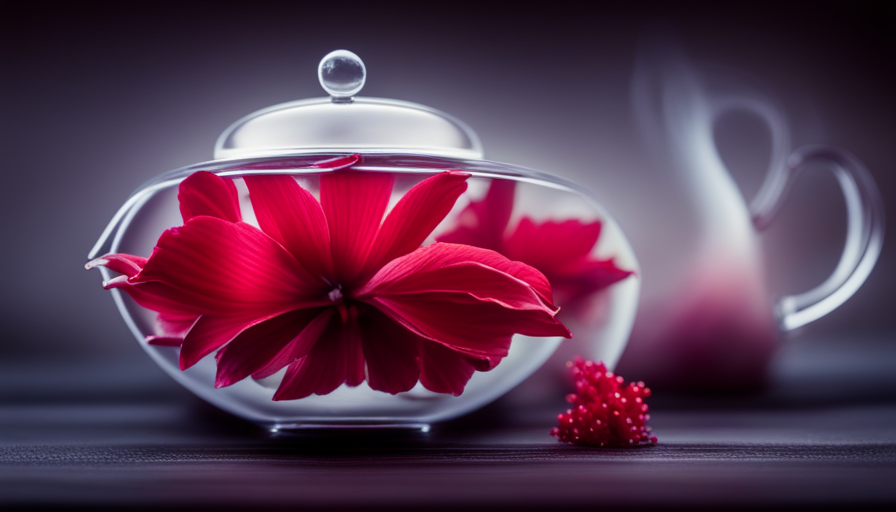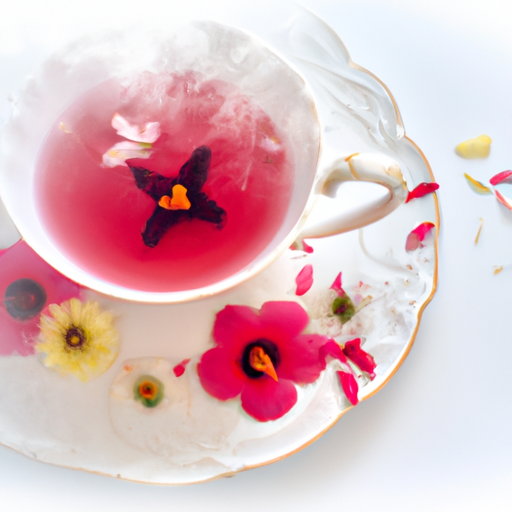As I find myself surrounded by a vibrant garden filled with lush passion flowers, their stunning colors and captivating aroma enchant my senses. These intricate blossoms, with their delicate petals and alluring fragrance, are essential for creating a truly unique tea experience. Harvesting passion flowers for tea is not just a process of discovering nature’s secrets, but also a way to enjoy the many benefits they provide.
Passion flower tea, derived from the Passiflora plant, has been cherished for centuries for its calming and soothing properties. From reducing anxiety and promoting better sleep to relieving menstrual cramps and aiding digestion, this herbal infusion is truly a treasure trove of wellness.
In this article, I will guide you through the fascinating process of harvesting passion flowers for tea. Together, we will explore how to identify and select the perfect plant, determine the optimal time for harvest, and learn the essential tools and techniques required.
Join me on this botanical adventure as we delve into the art of cultivating, harvesting, and brewing our very own homemade passion flower tea.
Key Takeaways
- Select a passion flower plant with large, vibrant leaves known for their calming properties.
- Harvest passion flowers when they have fully bloomed with vibrant petals and yellow or orange stamens.
- Use clean, sharp scissors or pruning shears to gently pluck the flowers, removing the entire flower head.
- Properly dry and store the passion flower leaves to retain their beneficial compounds and flavors.
Understanding the Benefits of Passion Flower Tea
If you’re looking to reap the full rewards of passion flower tea, you’ll want to understand its multitude of benefits. Passion flower tea is not only delicious, but it also possesses various medicinal properties that can promote overall well-being. Understanding the medicinal properties of passion flower tea is crucial in harnessing its full potential.
This tea has been used for centuries in traditional medicine to treat anxiety, insomnia, and even digestive disorders. Studies have shown that passion flower tea can help reduce anxiety levels and improve sleep quality, thanks to the natural compounds it contains, such as flavonoids and alkaloids. Additionally, passion flower tea has anti-inflammatory and analgesic effects, making it useful in alleviating pain and reducing inflammation in the body.
Exploring the history and cultural significance of passion flower tea adds depth to the appreciation of this herbal beverage. Native to the Americas, passion flower has a rich history in indigenous cultures as a symbol of spirituality and tranquility. It was believed to have calming effects on the mind and body and was often used in rituals and ceremonies. Today, passion flower tea continues to be a popular choice for those seeking a natural way to relax and unwind.
Now that we understand the benefits of passion flower tea, let’s delve into the next section on identifying and selecting the right passion flower plant.
Identifying and Selecting the Right Passion Flower Plant
To identify and select the right passion flower plant for making tea, you should look for a vine with large, vibrant leaves that have a unique shape and are known for their calming properties. For example, imagine you are strolling through a lush garden and come across a vine with heart-shaped leaves that are a deep shade of green, giving off a soothing aroma that instantly relaxes you.
Here is a table that can help you in selecting passion flower varieties:
| Variety | Leaf Shape | Leaf Color | Aroma | Calming Properties |
|---|---|---|---|---|
| Passiflora incarnata | Heart-shaped | Deep green | Soothing | Yes |
| Passiflora edulis | Palmate | Dark green | Fruity | No |
| Passiflora caerulea | Lobed | Light green | Floral | Yes |
| Passiflora lutea | Three-lobed | Yellowish-green | Citrusy | Yes |
| Passiflora foetida | Palmate | Light green | Pungent | No |
When caring for passion flower plants, it is important to provide them with well-drained soil, full sun exposure, and a trellis or support structure for the vine to climb. Regular watering is necessary, especially during dry spells. Pruning should be done in early spring to remove dead or damaged stems and promote new growth.
Now that you have identified and selected the right passion flower plant, the next step is to choose the optimal time to harvest the flowers for tea.
Choosing the Optimal Time to Harvest
When determining the ideal moment for gathering the blossoms, it’s crucial to consider the stage of maturity and the overall health of the plant. Harvesting passion flowers at the optimal time ensures that the flavor and aroma of the tea are preserved.
To begin, observe the flowers closely and wait until they’ve fully bloomed and opened. This is when they’re at their most fragrant and flavorful. The petals should be vibrant and the stamens, the long, slender structures in the center of the flower, should be yellow or orange in color.
It’s important to avoid harvesting flowers that are wilted, damaged, or showing signs of disease or pests. These flowers may not yield the desired flavor and could potentially contaminate the tea.
To harvest the flowers, gently pluck them from the plant, making sure to remove the entire flower head. It’s best to use clean, sharp scissors or pruning shears to prevent damage to the plant. Be mindful not to disturb the surrounding foliage or other flowers.
By following these optimal harvesting techniques, you can ensure the best flavor for your passion flower tea. Now, let’s move on to the next section about preparing for harvesting: tools and equipment.
Preparing for Harvesting: Tools and Equipment
Get ready for the harvest by gathering the necessary tools and equipment, ensuring you have everything you need to capture the essence of nature’s delicate treasure. When it comes to tools selection, it is important to choose ones that are specifically designed for harvesting delicate flowers like passion flower blossoms. Here are some essential tools you will need:
| Tools | Purpose |
|---|---|
| Pruning shears | To carefully cut the mature stems |
| Garden gloves | To protect your hands from thorns |
| Harvesting bag | To collect the harvested blossoms |
| Basket or tray | To transport the harvested blossoms |
Before you start harvesting, make sure your tools are clean and sharp. Dull or dirty tools can damage the flowers and affect the quality of the tea. When using pruning shears, always cut the stems at a 45-degree angle, about ¼ inch above a leaf node, to encourage new growth. It is important to only harvest mature stems with fully opened flowers, as they contain the highest concentration of beneficial compounds.
With your tools ready, you are now prepared to begin harvesting the passion flower blossoms, capturing their vibrant beauty and therapeutic properties.
Harvesting the Passion Flower Blossoms
Now that you have all your tools and equipment ready, it’s time to immerse yourself in the art of carefully collecting the exquisite blossoms of the passion flower. Harvesting the passion flower blossoms requires precision and a gentle touch to ensure the best quality for your tea.
Here are three essential techniques to guide you in the process:
-
Choose the right time: The best time to harvest passion flower blossoms is in the early morning when the flowers are fully open. This is when they contain the highest concentration of essential oils and aromatic compounds.
-
Handle with care: When harvesting the blossoms, gently grasp the stem just below the flower and give it a slight twist. This will detach the blossom without causing damage. Avoid pulling or yanking as it can harm the delicate petals.
-
Potential uses: Apart from making tea, passion flower blossoms can be used in various other ways. They can be added to potpourri, used in natural soaps or scented candles, or even dried and preserved as a beautiful decoration.
By mastering these harvesting techniques, you can ensure the best quality blossoms for your passion flower tea.
Now, let’s move on to the next step of the process, which involves drying and curing the passion flower leaves to preserve their flavors and aromas.
Drying and Curing the Passion Flower Leaves
Once you’ve successfully gathered the delicate blossoms, it’s time to start the process of drying and curing the leaves of this enchanting plant. Drying the passion flower leaves correctly is crucial to preserving their flavor and health benefits.
There are several drying techniques you can use, but the most effective method is air drying. Begin by spreading the leaves out in a single layer on a clean, dry surface, such as a wire mesh or a baking sheet lined with parchment paper. Make sure to choose a well-ventilated area away from direct sunlight to prevent the leaves from becoming brittle or losing their vibrant color.
Allow the leaves to air dry for about two weeks, or until they are completely crisp. During this time, it’s important to regularly check the leaves for any signs of mold or moisture. If you notice any, remove those leaves immediately to prevent contamination.
Drying the passion flower leaves properly is essential for preserving their health benefits. These leaves contain compounds such as flavonoids and alkaloids, which are known for their anti-anxiety and sleep-inducing properties. By air drying the leaves, you ensure that these beneficial compounds are retained, providing you with a potent and flavorful tea.
As you finish drying and curing your passion flower leaves, you’ll be ready to move on to the next step of storing and preserving your passion flower tea leaves.
Storing and Preserving Your Passion Flower Tea Leaves
To ensure that you can enjoy the full benefits of your passion flower tea, it’s important to know how to properly store and preserve the leaves. Storing passion flower leaves correctly will help maintain their freshness and potency over time.
Here are three key tips for storing and preserving your passion flower tea leaves:
-
Store in an airtight container: Transfer the dried passion flower leaves to a glass jar or airtight container to protect them from moisture and air exposure. This will help preserve their flavor and aroma for a longer period.
-
Keep away from light and heat: Store the container in a cool, dark place, such as a pantry or cupboard. Exposure to light and heat can degrade the quality of the leaves, so it’s important to keep them away from direct sunlight and high temperatures.
-
Check for freshness: Periodically check the leaves for any signs of mold, discoloration, or unpleasant odors. If you notice any of these signs, discard the leaves as they may have gone bad.
By following these storage and preservation techniques, you can ensure that your passion flower tea leaves remain fresh and flavorful for a long time.
Now that you have properly stored and preserved your leaves, let’s move on to the next section where we will learn how to brew and enjoy your homemade passion flower tea.
Brewing and Enjoying Your Homemade Passion Flower Tea
Get ready to savor the delightful taste and soothing effects of your own homemade passion flower tea by learning how to brew and enjoy it.
Brewing passion flower tea is a simple process that requires a few key techniques to ensure the best flavor and health benefits. To begin, gather your dried passion flower leaves and place them in a teapot or infuser.
Boil water and pour it over the leaves, allowing them to steep for about 5-10 minutes. This’ll release the beneficial compounds and flavors from the leaves. For a stronger brew, you can increase the steeping time, but be cautious not to overdo it as it may result in a bitter taste.
Once the tea has steeped, strain out the leaves and pour the tea into your favorite mug. You can enjoy the tea as is, or add a touch of honey or lemon for added flavor.
The health benefits of passion flower tea include promoting relaxation, reducing anxiety, and improving sleep quality.
Now that you know how to brew your own passion flower tea, let’s explore different recipes and blends that incorporate this wonderful herb.
Exploring Different Recipes and Blends with Passion Flower Tea
Discover the endless possibilities of incorporating this amazing herb into various recipes and blends, allowing you to unlock the full potential of passion flower’s soothing effects and delightful taste. Passion flower tea isn’t just a calming beverage on its own, but it can also be used as a base for creative infusions and blends. Here are three exciting ways to explore the health benefits and create unique flavor combinations with passion flower tea:
-
Citrus Burst: Infuse passion flower tea with freshly squeezed lemon juice and a touch of honey for a refreshing and tangy twist. This blend not only enhances the natural calming properties of passion flower but also provides a boost of vitamin C and antioxidants from the citrus.
-
Floral Fusion: Combine passion flower tea with dried lavender and chamomile flowers for a floral infusion that promotes relaxation and sleep. This aromatic blend is perfect for unwinding after a long day and can be enjoyed hot or iced.
-
Spiced Elixir: Add warming spices like cinnamon, ginger, and nutmeg to your passion flower tea for a cozy and comforting experience. This blend not only enhances the taste but also provides additional health benefits, including anti-inflammatory and digestive properties.
By exploring different recipes and blends, you can fully experience the health benefits and versatility of passion flower tea. Now, let’s move on to the next section and learn some tips for growing and maintaining your passion flower plant.
Tips for Growing and Maintaining Your Passion Flower Plant
Growing and maintaining your passion flower plant is a rewarding experience that requires proper care and attention. To ensure the health and vitality of your plant, it’s important to follow a few key tips for pruning passion flower plants.
Pruning should be done in early spring before new growth begins. Start by removing any dead or damaged branches, as well as any weak or crossing stems. This will help improve air circulation and prevent the spread of diseases. It’s also important to prune back any overly vigorous growth to maintain a manageable size and shape for your plant.
When it comes to pests and diseases, passion flower plants are generally resistant to most common pests. However, they can occasionally be susceptible to aphids, spider mites, and whiteflies. Regular inspection of your plant is key to catching any infestations early on. If pests are present, you can use an insecticidal soap or neem oil to control them.
As for diseases, passion flower plants can be prone to fungal infections such as powdery mildew. To prevent this, avoid overhead watering and provide good air circulation around your plant.
By following these tips for pruning and being vigilant against pests and diseases, you can ensure the health and longevity of your passion flower plant. Happy gardening!
Frequently Asked Questions
Can passion flower tea be consumed by pregnant women or individuals with certain medical conditions?
Pregnant women, take a sip of relief! Passion flower tea is generally considered safe for consumption during pregnancy. However, it’s always wise to consult with your healthcare provider to ensure it aligns with your specific condition.
As for individuals with medical conditions, passion flower tea may not be suitable for everyone. Certain conditions, such as low blood pressure or liver disorders, may require caution. Prioritize your health and seek professional guidance to ensure a safe and enjoyable tea experience.
How long does it take for passion flower plants to grow and produce flowers?
It usually takes passion flower plants about 1 to 2 years to grow and produce flowers. The growth stages of a passion flower plant include germination, seedling development, and vine growth.
To successfully grow passion flower plants, it’s important to provide them with well-drained soil, ample sunlight, and regular watering. Additionally, pruning the plants in early spring can stimulate new growth and promote flower production.
Following these tips can help ensure a healthy and thriving passion flower plant.
Are there any specific pests or diseases that commonly affect passion flower plants?
When it comes to passion flower plants, there are indeed specific pests and diseases that commonly affect them. In terms of pest control, the most common culprits are aphids, spider mites, and caterpillars. Regular inspection and application of organic insecticides can help keep these pests at bay.
As for diseases, fungal infections like Fusarium wilt and leaf spot can pose a threat. Proper watering, good air circulation, and timely removal of infected plant parts are essential for disease prevention.
Can passion flower tea be used for purposes other than relaxation and sleep aid?
Passion flower tea, aside from being a popular relaxation and sleep aid, has potential alternative uses. Studies suggest that it may have anti-inflammatory and antioxidant properties, making it beneficial for skin health and reducing the risk of chronic diseases.
However, it’s important to note that passion flower tea may have potential side effects, such as dizziness, nausea, and altered consciousness. As with any herbal remedy, it’s crucial to consult with a healthcare professional before incorporating passion flower tea into your routine.
Is it possible to grow passion flower plants indoors or in colder climates?
Yes, it’s possible to grow passion flower plants indoors or in colder climates through indoor gardening and cold climate gardening. Passion flowers are hardy plants that can tolerate a range of temperatures. To grow them indoors, provide a sunny spot near a window, use well-draining soil, and maintain a consistent temperature.
In colder climates, they can be grown in containers and brought indoors during the winter months. With proper care and attention, passion flowers can thrive in these environments.
Conclusion
In conclusion, harvesting passion flower for tea is a rewarding and fulfilling process. By understanding the benefits of passion flower tea and selecting the right plant, you can ensure a high-quality harvest.
Timing is crucial, as harvesting at the optimal time will yield the best results. With the right tools and equipment, you can carefully harvest the passion flower blossoms and store them properly for future use.
Brewing and enjoying your homemade passion flower tea is a delightful experience, and exploring different recipes and blends adds a depth of flavor. Additionally, growing and maintaining your passion flower plant allows for a continuous supply of fresh leaves.
By investigating the truth of a theory, we can further enhance our understanding of the passion flower and its potential benefits.










